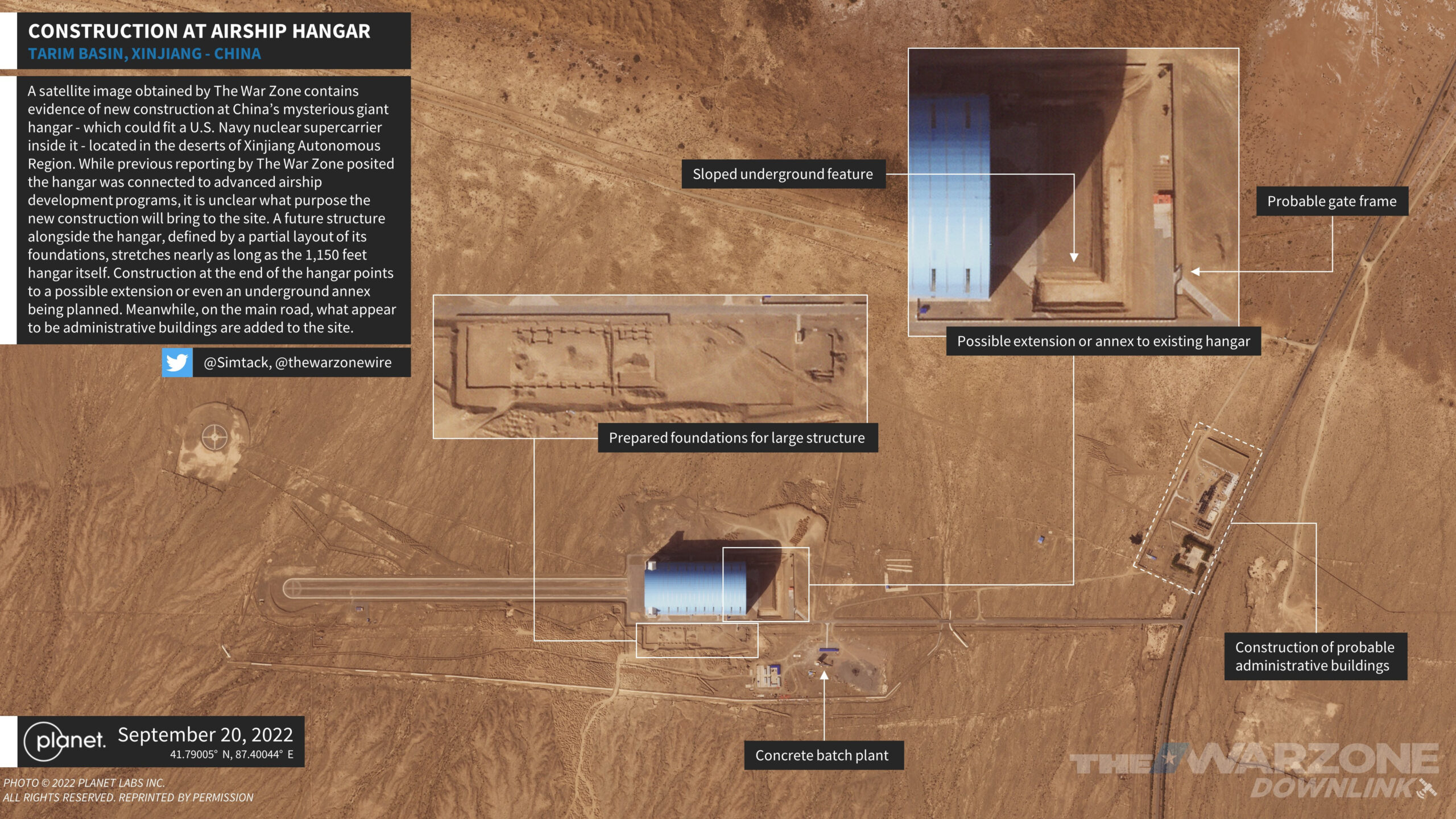Pictures that show what could be a high-altitude, long-endurance airship flying in the vicinity of the northern Philippine island of Luzon near the South China Sea have recently emerged. The Chinese military, among others, is known to be exploring high-flying lighter-than-air platforms capable of performing intelligence, surveillance, and reconnaissance missions and other tasks across long distances and for long durations, which would be well suited to operations in this region, as The War Zone has previously reported on in detail.
The photographs in question appear to have first emerged on Facebook this past weekend, though the original post seems to have now been deleted or locked from public view. The images are still circulating on social media, including after being picked up by local media in the Philippines, as you can find here.
The pictures are said to have been taken by an individual in the province of Pangasinan on Luzon, the western part of which juts out into the northern end of the South China Sea, but there does not appear to be any readily available information about when they were supposedly taken.

From what is seen, the object would look to be a teardrop-shaped airship with four tail fins. It’s not entirely clear from the images whether it might have a translucent exterior or a metallic-like one. It seems more likely to be the latter, with the pictures that show it far away indicating that it is highly reflective. However, this effect could be produced by various types of materials when viewed from a significant distance.
Given how far away it appears to be from the person taking the photographs, it is difficult to gauge its size or how high it might be flying. It is also not clear whether or not it might have any kind of propulsion system or other equipment fitted.
Overall, the apparent airship’s general shape has broad similarities to a number of high-altitude, long-endurance types that Chinese companies are known to have been working on. This includes at least two uncrewed solar-powered designs, the Tian Heng and Yuan Meng, with external propulsion and other systems intended primarily for operations at stratospheric altitudes, both of which have reportedly been test flown at least once. The stratosphere is commonly defined as lying between 23,000 to 66,000 feet above the Earth’s surface, with those measurements varying depending on one’s specific location, and airships of this type are typically intended for operations at the higher end of that range.


Those projects, the status of which is unclear, and others may have ties to a huge airship hangar situated south of Bosten Lake in China’s far western Xinjiang Autonomous Region. Last year, The War Zone reported in detail on this facility, which satellite imagery showed had grown significantly in size and scope since construction first began sometime around 2013.
Our Downlink team more recently analyzed a satellite image from Planet Labs of the site taken on September 20 of this year, which shows additional construction, including work on what may be an extension or annex to the hangar and new associated administrative buildings. A review of subsequent imagery available from Plant Labs does not appear to indicate any new major developments since then.

This hangar and its adjacent structures are located near a number of other facilities tied to the People’s Liberation Army and, more specifically, to missile defense and anti-satellite weapon programs. Stratospheric airships certainly have potential applications in these roles, but could also perform a host of missions, including intelligence, surveillance, and reconnaissance (ISR).
One 2018 academic paper published in the Chinese Journal of Aeronautics, which touches on the Tian Heng design specifically, notes that a very-high-flying, long-endurance airship could offer an “affordable part substitute for a near-earth orbit satellite or… eliminate the need for multiple aircraft sorties to sustain continuous on-station keeping” while performing tasks related to “earth observation, maritime monitoring, missile warning, communication signal relays, etc.”
For the Chinese military, deploying a high-altitude, long-endurance airship into the South China Sea, specifically, even on an experimental basis, could make sense on a general level. Platforms capable of providing general ISR, maritime surveillance, and communications and data-sharing relay support persistently across very large areas would all benefit Chinese forces spread across this region, including those deployed on various relatively remote man-made island outcroppings. At least one tethered aerostat, a lighter-than-air system attached to a fixed anchor on the ground that could provide more limited and localized surveillance and other capabilities, but for long periods at a time, has appeared on one of these islands in the past.

Stratospheric airships, in particular, may have the benefit of being able to fly at altitudes above where typical fighter aircraft can go, making intercepting and examining them closely a challenge. Operating at those heights, the chances of observers on the ground spotting these aerial craft may also be difficult to track on traditional radars due to their shape, construction, and slow speed. This, in turn, might make it possible to pass over certain areas and collect information unopposed.
Even if individuals down below, like the person who reportedly took the pictures in Pangasinan, do see airships flying overhead, the difficulty in readily identifying them could cause useful confusion and the possibility of the whole thing being written off as an unsubstantiated sighting of an unidentified flying object. There are strong indications that many reports about UFOs, now also commonly called unidentified aerial phenomena (UAP), are in fact sightings of uncrewed air vehicles of various kinds, including different types of drones and balloons, as The War Zone has written about in-depth in the past.
An airship operating near the Philippines specifically would also not be surprising given the particularly significant friction in recent years between the two countries over disputed maritime boundaries in the South China Sea. The South China Sea, in general, is an area of strategic interest for various countries and therefore sees significant aerial activity on a regular basis.
If the pictures that were reportedly taken near Pangasinan recently do indeed show a high-altitude, long-endurance airship, there is, of course, a possibility that it could belong to another country, as well. The U.S. military has long had an on-and-off-again interest in various tiers of light-than-air craft, including designs that have similar shapes to the one seen in the images currently circulating online, such as Lockheed Martin’s High-Altitude Long Endurance-Demonstrator (HALE-D), which you can learn more about here.

The HALE-D crashed during its first test flight in 2011. A subsequent effort that leveraged the work on HALE-D, called the Integrated Sensor Is Structure (ISIS), came to an end in 2014. These are just some of the lighter-than-air projects the U.S. military has pursued over the years.
The U.S. military’s recent refocusing on potential operations in the Pacific region, especially in light of a possible high-end conflict against the Chinese, has helped reinvigorate interest in airships and other high-flying, very long-endurance platforms. The Pentagon does see future applications for them elsewhere, too. The bulk of the current focus, at least in the unclassified realm, in this regard has been on high-altitude balloon-based systems.
With all this in mind, a tethered aerostat breaking free from its mooring, something that definitely happens from time to time, is another potential explanation for what was reportedly seen in Pangasinan.
None of this necessarily precludes the possibility that what is seen in the images reportedly taken by the individual in Pangasinan is something far more benign. The general capabilities that high-flying airships offer present potential advantages for various commercial sectors, in addition to armed forces around the world. In June, for instance, Sceye Inc. conducted a flight test of a solar-powered design that is visually similar, in broad strokes, to what is seen in the pictures reportedly taken in the Philippines and that the company said could be used to monitor industrial pollution, help provide broadband internet access to austere locations, and support other commercial and scientific endeavors. A number of other firms have also been pitching airships for long-distance heavy-lift cargo work.

It could even just be a novelty of some kind, like a very large party balloon that looks larger and farther off than it is. That the pictures have been fabricated, at least in part, cannot be entirely ruled out at this time, either.
Still, the images are somewhat compelling and we have seen strange activity like this in the same general area before. Last year, another photographer in a city at the southeastern end of Luzon captured images of what appeared to be a high-altitude, long-endurance drone with a flying wing-type planform. This could have been a sighting of a secretive U.S. stealth drone commonly referred to as the RQ-180, among other possibilities, including those belonging to China, as you can read more about in The War Zone‘s reporting at the time.
All told, it remains unclear what may or may not have been recently seen in the air near Pangasinan in the Philippines. At the same time, reported sightings of airships and other similar light-than-air craft floating around the South China Sea and other areas of the Pacific seems like something that could well be set to grow in the future.
Contact the author: joe@thedrive.com
